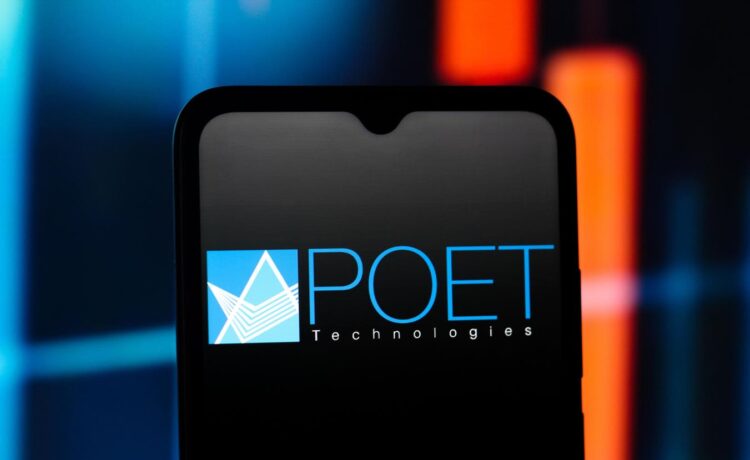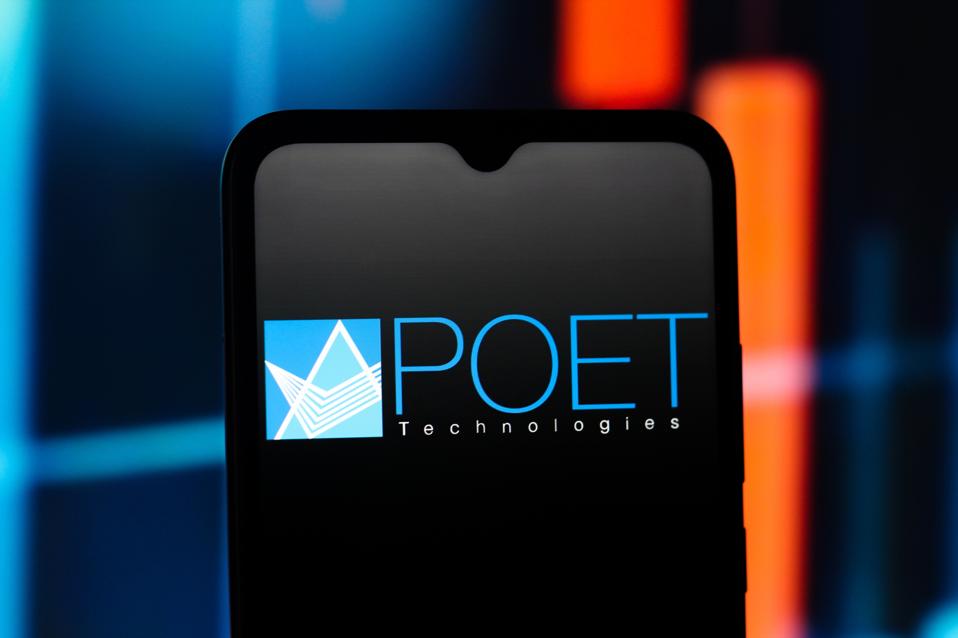CANADA – 2025/10/08: In this photo illustration, the POET Technologies logo is seen displayed on a smartphone screen. (Photo Illustration by Thomas Fuller/SOPA Images/LightRocket via Getty Images)
SOPA Images/LightRocket via Getty Images
POET Technologies stock (NASDAQ: POET) experienced an increase of nearly 10% on Monday and is still up approximately 60% for the past month. The firm, which creates silicon photonics solutions that utilize light instead of electricity to transfer data between chips, has garnered heightened investor interest due to excitement surrounding artificial intelligence infrastructure investments, a recent capital raise of $75 million, and a series of new partnerships, which are bringing the company closer to commercialization. So, is the stock a worthwhile purchase at this time?
POET stock has increased notably in recent times, but there is considerable risk in depending on a single equity. Nonetheless, a broader, diversified strategy has substantial advantages, as seen with Trefis High Quality Portfolio. Additionally, ponder what your portfolio’s long-term performance could look like if it included 10% commodities, 10% gold, and 2% crypto combined with equities.
What POET Does
Interconnects serve as the physical connections that facilitate data transfer between chips, servers, and systems within data centers. Conventional electrical interconnects, which rely on copper wiring, are increasingly falling short of the vast data transfer demands of AI tasks due to limitations in speed, energy efficiency, and heat dissipation. These limitations result in bandwidth bottlenecks, elevated energy consumption, and expensive cooling needs, constraining the scalability of AI infrastructure. Conversely, optical interconnects, like those engineered by POET Technologies, substitute electrical signals with light for transmission, permitting multi-terabit data transfer rates, lower power consumption, and minimized heat production. This makes them essential for the upcoming wave of AI and high-performance computing systems.
While other competitors exist in this niche, including Ayar Labs, Celestial AI, and Ranovus, POET’s Optical Interposer merges photonics and electronics on a single wafer, tackling cost, scalability, and manufacturability challenges more efficiently than its competitors by omitting traditional expensive photonics assembly steps. The company’s core breakthrough, the Optical Interposer, combines electronic and photonic elements on one chip, enabling data transmission speeds of 800G and 1.6T aimed at next-generation AI and high-performance computing systems.
Reasons for the Stock’s Recent Uptrend
Several factors have contributed to the stock’s upward trajectory. The firm secured $75 million in new investments just last week, which could provide it with the means to enhance product development and expand production. Additionally, POET has established strategic partnerships with Foxconn, Semtech, and notably Sivers Semiconductors in recent times. The collaboration with Foxconn centers on the development of 800G and 1.6T plug-in optical transceiver modules utilizing POET’s silicon photonics optical engine technology, with Foxconn responsible for designing and manufacturing the high-speed transceivers for clients globally, leveraging their manufacturing proficiency.
POET and Semtech have unveiled 1.6T high-performance optical receivers that integrate Semtech’s FiberEdge 200G-per-lane receiver technology with POET’s Optical Interposer platform. Furthermore, POET recently initiated a strategic collaboration with Sivers Semiconductors to combine Sivers’ high-power distributed feedback laser technology with POET’s optical interposer platform, aiming to develop scalable, cost-effective solutions for AI clusters and hyperscale data centers.
Valuation and Risks
POET is still in the nascent stages of commercialization. The company reported revenues of less than $300,000 for Q2 2025. Over the preceding 12 months, operating losses totaled $-28 million. The future of POET heavily hinges on successful product adoption and the ability to increase production, making it a rather speculative investment. Its valuation appears stretched, with the stock trading at over 60 times projected revenue for 2026, offering minimal margin for execution risk. With a market capitalization below $900 million, POET is also classified as a small-cap stock, which may entail greater volatility and reduced liquidity. Overall, POET seems to be a high-risk, high-reward investment on the ascent of AI infrastructure, although substantial gains will rely on how effectively it implements its product roadmap and transforms partnerships into tangible revenue in the upcoming quarters.
The Trefis High Quality (HQ) Portfolio, featuring a selection of 30 stocks, has a history of outperforming its benchmarks, which include the S&P 500, Russell, and S&P midcap. What accounts for this? Collectively, HQ Portfolio stocks have delivered superior returns with less risk compared to the benchmark index, presenting a smoother investment experience, as demonstrated in HQ Portfolio performance metrics.



